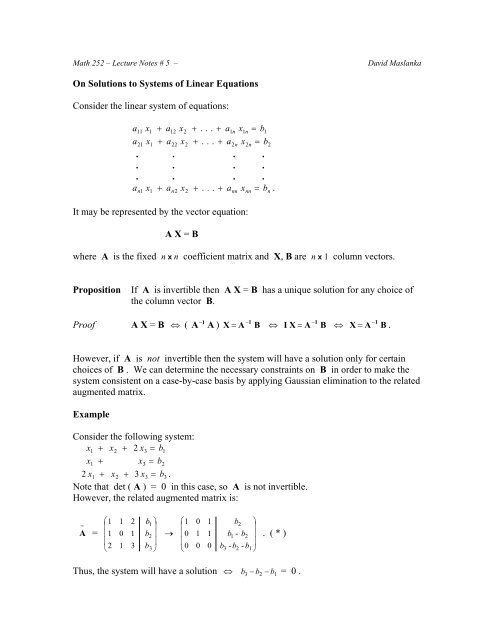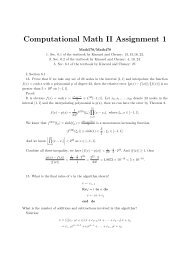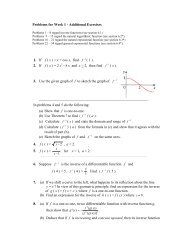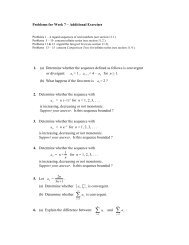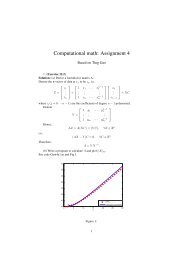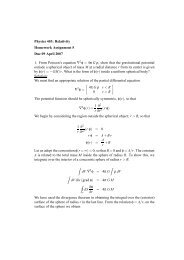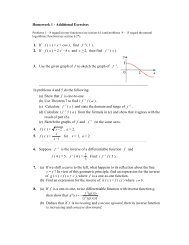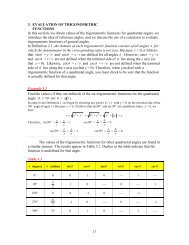5 Lecture Notes on Solutions to Systems of Linear Equations (pdf ...
5 Lecture Notes on Solutions to Systems of Linear Equations (pdf ...
5 Lecture Notes on Solutions to Systems of Linear Equations (pdf ...
Create successful ePaper yourself
Turn your PDF publications into a flip-book with our unique Google optimized e-Paper software.
Math 252 – <str<strong>on</strong>g>Lecture</str<strong>on</strong>g> <str<strong>on</strong>g>Notes</str<strong>on</strong>g> # 5 –David MaslankaOn Soluti<strong>on</strong>s <strong>to</strong> <strong>Systems</strong> <strong>of</strong> <strong>Linear</strong> Equati<strong>on</strong>sC<strong>on</strong>sider the linear system <strong>of</strong> equati<strong>on</strong>s:aa11x1+a12x2+ . . . + a b1n x1n=2n x2n=21 x1+ a22x2+ . . . + a b. . . .. . . .. . . .an1 x1an2x2+ . . . + annxnn=+ b .12nIt may be represented by the vec<strong>to</strong>r equati<strong>on</strong>:A X = Bwhere A is the fixed n x n coefficient matrix and X, B are n x 1 column vec<strong>to</strong>rs.Propositi<strong>on</strong>If A is invertible then A X = B has a unique soluti<strong>on</strong> for any choice <strong>of</strong>the column vec<strong>to</strong>r B.Pro<strong>of</strong> A X = B ⇔ ( A − 1 A ) −1X = A B−1−1⇔ I X = A B ⇔ X = A B .However, if A is not invertible then the system will have a soluti<strong>on</strong> <strong>on</strong>ly for certainchoices <strong>of</strong> B . We can determine the necessary c<strong>on</strong>straints <strong>on</strong> B in order <strong>to</strong> make thesystem c<strong>on</strong>sistent <strong>on</strong> a case-by-case basis by applying Gaussian eliminati<strong>on</strong> <strong>to</strong> the relatedaugmented matrix.ExampleC<strong>on</strong>sider the following system:x + x + 2 x = b1 2 3 11 + x3b2x =2 x 1 + x2+ 3 x3= b3.Note that det ( A ) = 0 in this case, so A is not invertible.However, the related augmented matrix is:~A =⎛1⎜⎜1⎜⎝2101213b1⎞⎟b2⎟⎟b3⎠→⎛1⎜⎜0⎜⎝001011031b22b - bb - b2- b⎞⎟⎟⎟⎠1. ( * )Thus, the system will have a soluti<strong>on</strong> ⇔ b3 − b2− b1= 0 .
In which case B =and then from ( * ) :⎛ b⎜⎜ b⎜⎝b121 + b 2⎞⎟⎟⎟⎠−xx11+x2+xx33=b12= b −b2− x2= 2 b2− b1⇒ x 1 = 2 b2− b1+ x2and x3 b1− b2− x2= .Setx 2 = t then x 1 = 2 b2− b1+ t and x = b1− b2− t3 .⎛2b2−b1⎞⎜ ⎟⎜ ⎟⎜ ⎟⎝ b1−b2⎠So X = 0+ t⎛ 1 ⎞⎜ ⎟⎜ 1 ⎟⎜ ⎟⎝−1⎠is a soluti<strong>on</strong> vec<strong>to</strong>r for any real twhenever B =⎛ b⎜⎜ b⎜⎝b121 + b 2⎞⎟⎟⎟⎠.Propositi<strong>on</strong>If A is a fixed m x n matrix and B is a fixed m x 1 column vec<strong>to</strong>rthen the system <strong>of</strong> equati<strong>on</strong>s A X = B has either:( i ) no soluti<strong>on</strong>( ii ) a unique soluti<strong>on</strong>( iii ) an infinite number <strong>of</strong> soluti<strong>on</strong>s.Pro<strong>of</strong> We will <strong>on</strong>ly show that if X 1 and X 2 are distinct soluti<strong>on</strong>s <strong>to</strong> A X = Bthen the system possesses an infinite number <strong>of</strong> soluti<strong>on</strong>s.Given the soluti<strong>on</strong>s X 1 and X 2 we set X 0 = ( X1 − X 2 ) and let k denoteany real scalar. ThenA X 1 = B and A X 2 = B ⇒ A X 1 – A X 2 = B – B = O .⇒ A ( X 1 – X 2 ) = O.⇒ A X 0 = O.Observe that A ( X 1 + k X 0 ) = A X 1 + A( k X 0 )= A X 1 + k (A X 0 )= B + k O= B .Therefore, X = X 1 + k X 0 is a soluti<strong>on</strong> for any real scalar k .Hence, A X = B has an infinite number <strong>of</strong> soluti<strong>on</strong>s.


